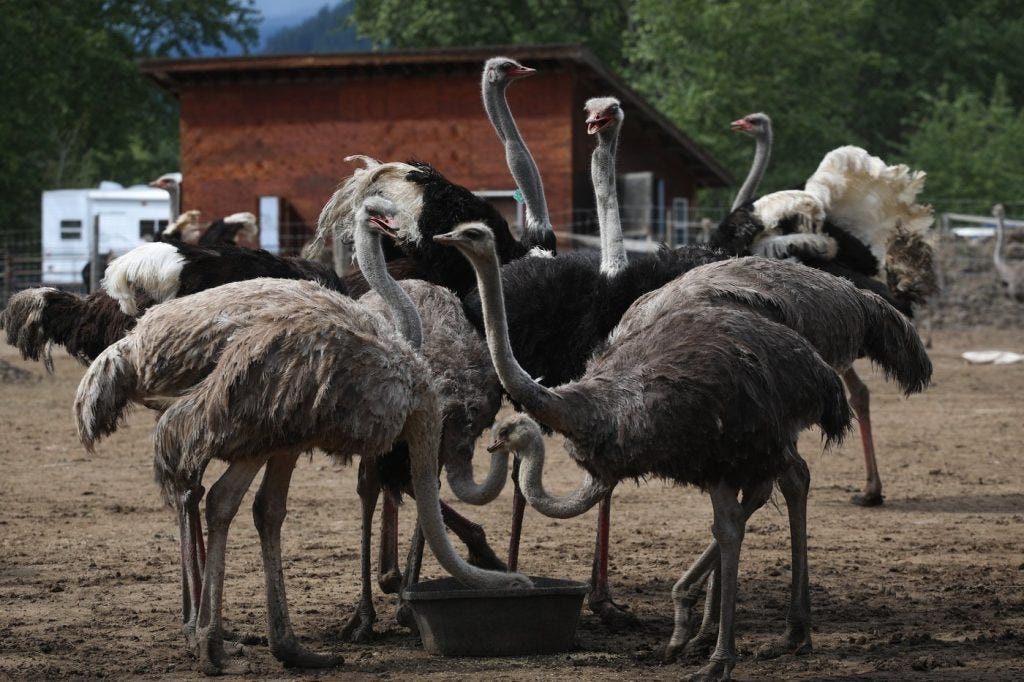🕊️ Flightless and Condemned: The Tragedy of Canada’s Ostrich Cull
When the state meets the wild, and compassion meets control — a quiet farm in British Columbia becomes the battleground for one of the most haunting stories of our time.
When the wind howls across the Kootenay valley, the sound of wings never comes.
Only the echo of boots, engines, and the low hum of bureaucracy.
On a quiet farm in Edgewood, British Columbia, nearly four hundred ostriches—creatures too big to ignore and too gentle to fight—were caught in the crossfire between government policy and human conviction.
What began as a few unexplained deaths in December 2024 has now become one of the most controversial animal welfare and agricultural crises in modern Canadian history. The story of Universal Ostrich Farms is about more than bird flu—it’s about control, ethics, and what happens when a system built on caution loses sight of compassion.
🦩 The Outbreak
Two ostrich carcasses sent for testing came back positive for H5 avian influenza—a highly pathogenic strain that has ravaged poultry flocks worldwide.
The Canadian Food Inspection Agency (CFIA) responded by issuing a “Notice to Dispose”—a legal order to cull every potentially exposed bird on the property.
To the CFIA, this was standard procedure.
To the farmers, it was unthinkable.
“We were 221 days healthy,” said co-owner Katie Pasitney. “Our birds showed no signs of illness. They had survived what nature threw at them. They deserved to live.”
The farm argued that its surviving birds were healthy, perhaps immune, and that their blood might even hold valuable antibodies. But CFIA officials said the risk of viral mutation or spread, especially among exotic species, outweighed every other consideration.
⚖️ The Legal Fight
In early 2025, the farm sought injunctions, judicial reviews, and independent testing.
In May, the Federal Court ruled against them. In August, the Federal Court of Appeal upheld the decision.
Then came a brief reprieve: in September 2025, the Supreme Court of Canada issued a temporary stay of execution—literally—for the ostriches, pending review.
For a few tense weeks, activists camped at the gate. Protesters held handmade signs. The farm built hay-bale barricades. The birds lived.
Then, in early November, the Supreme Court declined to hear the case.
The stay was lifted.
The guns returned.
Within days, the CFIA—with RCMP support—entered the property and began the cull.
By mid-month, the ostriches of Edgewood were gone.
Some reports said 300. Others said nearly all.
🌍 A Story That Went Global
What might have been a quiet provincial dispute exploded into an international controversy.
American figures Robert F. Kennedy Jr. and Dr. Mehmet Oz offered to relocate the birds to U.S. sanctuaries for study. The CFIA refused, citing global health protocols and Canada’s trade obligations.
“The CFIA cannot allow potentially infected animals to cross borders,” a spokesperson said. “Containment and protection of public and animal health must come first.”
But to many observers, this wasn’t about health anymore—it was about power.
It was about the cold calculus of biosecurity in an age that has forgotten empathy.
🧬 Beyond Biosecurity
Since 2021, over 14 million birds have been destroyed in Canada to contain outbreaks of Highly Pathogenic Avian Influenza.
But ostriches aren’t poultry. They are long-lived, sentient, social creatures with complex behaviours and intelligence rivalling mammals.
Each bird represented years of selective breeding and adaptation to the Canadian climate—a unique genetic line, now erased.
“They weren’t just animals,” said one local supporter. “They were a family, a legacy. We could have learned from them. Instead, we incinerated knowledge.”
This is the haunting irony: in the pursuit of safety, we often destroy the very resilience we claim to protect.
💰 The Economics of Fear
The CFIA’s defenders make a strong case. Canada’s poultry industry—worth nearly $7 billion a year—depends on keeping export markets open.
An uncontrolled outbreak, even in an unconventional species, could lead to bans, trade losses, and economic catastrophe.
From that perspective, Edgewood’s ostriches were collateral damage in a much larger system of survival.
And yet… one can’t help but ask:
What kind of system requires erasing life to prove it’s in control?
🔥 The Symbolism of the Flightless Bird
The ostrich has always been a paradox: massive yet delicate, grounded yet majestic.
In myth, it symbolizes denial—the bird that hides its head in the sand.
But in this story, it isn’t the ostrich that’s blind. It’s us.
We live in an era that measures safety in terms of eradication.
The logic of “stamping out” has become the philosophy of modern governance: eliminate what threatens the system, even if that means eliminating what makes the system worth protecting.
🕯️ What Remains
The farm is empty now.
The fields are quiet.
The headlines have moved on.
But something deeper lingers in the silence: a question about who we are when faced with fear.
How far will we go to preserve control?
Can we value life beyond its economic worth?
And what happens when a country known for compassion becomes defined by compliance?
“Flightless, yet not powerless. Grounded, yet reaching for a voice.”
In the end, the ostriches of Edgewood remind us that compassion is not weakness—it’s resistance.
In a world obsessed with control, sometimes the bravest act is to let something live.
✍️ ThinkerCast Reflections
This story sits at the intersection of ethics, policy, and power. It forces us to ask how much authority is too much—and what humanity looks like in a system that no longer remembers what it’s defending.
Because when flightless birds become symbols of freedom, perhaps it’s time we looked in the mirror.


